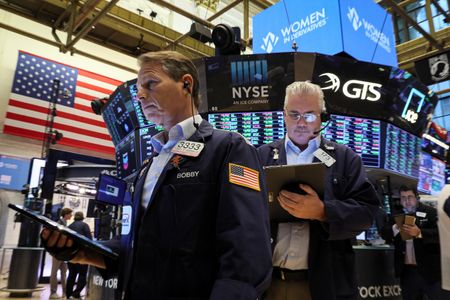


By Sinéad Carew, Shreyashi Sanyal and Sabahatjahan Contractor
(Reuters) – Wall Street’s three major indexes advanced on Friday, led by gains in recently battered technology stocks, after talks between U.S. President Joe Biden and Chinese President Xi Jinping over the Ukraine crisis ended without big surprises.
Investors were also eying slowing gains in oil prices as they continued to digest the Federal Reserve’s Wednesday interest rate increase aimed at combating soaring inflation, its aggressive plan for further hikes, and its trimming of economic growth projections.
China’s Xi told Biden that the war in Ukraine must end as soon as possible, but he did not assign blame to Russia for its invasion. Biden was expected to tell Xi that Beijing would pay a steep price if it supports Russia’s actions in Ukraine, though the White House did not immediately comment after the call.
“There’s been nothing to disrupt the momentum we saw earlier in the week,” said Steve Sosnick, chief strategist at Interactive Brokers in Greenwich, Connecticut.
In addition to the Fed’s actions being less onerous than the market had feared, Sosnick said investors were reassured that oil prices weren’t too far above $100 and were set for a second straight weekly loss, after a volatile trading week. [O/R]
“At least for this week oil has found a level. That’s someway positive for the market as a rising oil price is overweighted in consumer minds as an inflationary indicator,” he said. “Does the market like oil around $100? No. But is it happier that it’s around $100 than going up $20 every day? Of course.”
Investors were also monitoring for any impact from Friday’s “triple witching,” in which investors unwind positions in futures and options contracts before they expire, which can lead to volatility and higher volume of trades.
By 2:29 p.m. ET, the Dow Jones Industrial Average rose 54.68 points, or 0.16%, to 34,535.44, the S&P 500 gained 26.33 points, or 0.60%, to 4,438, and the Nasdaq Composite added 187.22 points, or 1.38%, to 13,802.00.
Five of the 11 major S&P 500 sectors were gaining, with heavyweight technology up 1.5% followed by consumer discretionary up 1.1%, and communication services rising 0.9%. The Philadelphia chip index was outperforming with a 1.6% gain.
“The bottom has been touched, and technology is down such a significant amount from its highs, it was bound to bring in people looking for opportunities,” said Rick Meckler at Cherry Lane Investments in New Vernon, New Jersey.
Wall Street’s main indexes were on track for their biggest weekly gain since November 2020 after a rally fueled by hopes for progress in the Russia-Ukraine peace talks earlier in the week and the release of pent-up anxiety following the highly anticipated Fed meeting.
The biggest sector decliner was utilities, down 0.8%, followed by industrials, down 0.3%.
Moderna Inc gained 4% after the drugmaker submitted a request to the U.S. Food and Drug Administration to allow for a second booster of its COVID-19 vaccine.
Shares of Boeing Co rose 0.7% after reports the planemaker was edging toward a landmark order from Delta Air Lines for up to 100 of its 737 MAX 10 jets.
U.S. delivery firm FedEx Corp shares fell about 5% after a weaker-than-expected quarterly earnings report.
Advancing issues outnumbered declining ones on the NYSE by a 1.83-to-1 ratio; on Nasdaq, a 1.98-to-1 ratio favored advancers.
The S&P 500 posted 19 new 52-week highs and no new lows; the Nasdaq Composite recorded 37 new highs and 33 new lows.
(Reporting by Shreyashi Sanyal and Sabahatjahan Contractor in Bengaluru and Sinead Carew in New York; Editing by Sriraj Kalluvila and Leslie Adler)

